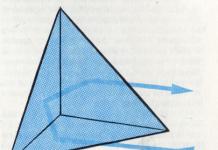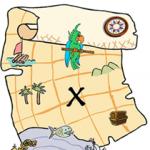In the industrial harvesting of roundwood, it is quite difficult to determine its cubic capacity. To accurately calculate the volume of each log, you can use the truncated cone volume formula, which takes into account the main diameters of both cuts and the length of the log itself.
Round wood is very convenient and practical for building houses, baths and other residential and non-residential premises.
In fact, the cubic size of the roundwood is not calculated in such a complicated way. It is accepted all over the world to count it in a faster way. Special tables are used for this.
How to calculate the cubic capacity of a single tree without additional measurements?

A few years ago, to calculate the volume of a single tree, they used the product of the arithmetic mean of the areas of saw cuts and the length of the tree. With the help of a meter (reminiscent of an ordinary caliper), the diameter of the tree in its middle part was determined. Then it was multiplied by 3 and the cross-sectional area was obtained.
Further, the resulting number was multiplied by the length of the workpiece, and a volumetric result was obtained. This method of calculation is inaccurate, since the thickness of the bark is not taken into account. The number Pi was taken with a large deviation from the real one, and the formula in its distorted form gave large errors.
The formula itself looks like this: the diameter of a rounded log is divided by 2 and squared, then multiplied by Pi and the length of the log.
Even if we measure the thickness of the bark and take this into account to determine the diameter of the tree itself, then deviations from these indicators will be inaccurate, although with a smaller error. More accurate calculations showed that the actual deviations in the calculations of the cubature of a round log with primitive measurements have a certain dependence on the parameters of the tree, which was taken into account when compiling the corresponding tables to determine the volumetric parameter. Let's try to figure out how to calculate the cubic capacity of the forest. This will require:
- roulette;
- the corresponding calculation tables, where there is a final cubature.
Back to index
?
Peculiarities .
How much does a board cube weigh?Technology for calculating the volume of a single log
First you need to use a tape measure to measure the length of the tree and its diameter on the cut in the upper part (excluding the bark). After that, let's look at the tabular parameters: at the intersection of the line, where the length of the tree is indicated, and the column indicating the corresponding diameter, we find the volume of the measured body. Everything is simple and reliable.
Such calculations also cannot be called absolutely accurate, since the features in which the forest was grown and the shape of the trunk were not taken into account. But it is customary not to pay attention to such trifles with large volumes of workpieces.
Back to index
Calculation of volume of cubic capacity of stockpiled timber
With industrial volumes of harvesting round logs, other methods and tabular data are used. In essence, a round forest in a stored state has the shape of a rectangular parallelepiped. Calculations of its volume are familiar to everyone from school. But it is impossible to use this method, since the dimensions of the voids between the logs will not be taken into account. By the way, they also directly depend on the diameter of the logs, which can be calculated mathematically.
Through numerous calculations, the coefficient was determined, with the help of which a special table was compiled. It works similarly to the previously described table, with the only difference that the volume of the mentioned parallelepiped and the average thickness of the upper cut are taken into account. The cubic capacity of the forest can be calculated with great accuracy.
But one cannot hope for good accuracy of calculations with inaccurate stacking of forest products. This procedure is not used in the warehouse storage of timber, since in this case the volume that the round timber occupies directly in the warehouse is estimated.
It is very easy to calculate the cubic capacity after preliminary weighing the forest.
Next, you need to calculate the volume by dividing the mass of the forest by the density, which corresponds to the type of wood. Such a calculation cannot be considered ideal either, since the forest in different degrees of maturity has a deviation in density. The humidity of the wood can also play a special role here.
If with the determination of weight and volume, for example, when buying liquids or bulk materials, no problems appear, then with timber the opposite is true. Here the system for determining the volume of the required number of this raw material raises a lot of questions, from the fact that no one wants to pay extra money.
Instruction
1.
2. First, the measured batch of business slab should be sorted into 2 groups. One group consists of boards with a length of more than 2 m, the other - less than 2 m. Stacking is carried out with thick and thin ends alternately in different directions, while the surface of the slab remains at the bottom and top. The stack must be super compact and tightly stacked at right angles and have an identical height.
4. The volume of lumber from softwood and hardwood can be determined by two methods. The 1st method provides for the freezing of the entire bar or board, and after that the volume, after which the results are summed up.
5.
6. Absolutely, that it is worth dwelling separately on measuring the cubature of a round forests. Here it is necessary to measure each log separately - the length and width of the upper and lower ends. The special tables according to which these calculations are made are called cubes, which were discussed above.
7. Later, after the volume of the entire log is measured separately, addition is made, and the total cubic capacity is obtained. At present, there is already a corresponding computer program.
If there are no problems with the determination of weight and volume, for example, when buying liquids or bulk materials, then the opposite is true with timber. Here the system for determining the volume of the required number of this raw material raises a lot of questions, from the fact that no one wants to pay extra money.

Instruction
1. It turns out that far from all customers realize how many types of wood actually exist. And tea, it differs from each other in the degree of processing, type, grade, which directly affects its cost. This is how the volume of slab is calculated - a hefty type of lumber in demand.
2. First, the measured batch of business slab should be sorted into 2 groups. One group consists of boards with a length of more than 2 m, the other - less than 2 m. Stacking is carried out with thick and thin ends alternately in different directions, while the surface of the slab remains at the bottom and at the top. The stack must be super compact and tightly stacked at right angles and have an identical height.
4. The volume of lumber from softwood and hardwood can be determined by two methods. The 1st method provides for the freezing of any bar or board, and after that the volume, after which the results are summarized.
5. 2nd method - with the help of a cube, a special table prepared for determining the volume of such lumber. The measurement of boards related to unedged lumber is performed somewhat differently. In this case, the width of a one-sided edged and unedged board is calculated as half the sum of the upper and lower planes.
6. Unconditionally, it is worth dwelling separately on measuring the cubic capacity of roundwood. Here it is necessary to measure each log separately - the length and width of the upper and lower ends. The special tables according to which these calculations are made are called cubes, which were discussed above.
7. Later, after the volume of each log is measured separately, addition is made and the total cubic capacity is obtained. At present, there is already a corresponding computer program.
Related videos
 16.06.2014 21:04
16.06.2014 21:04
After all the ideas for the implementation of the construction of the house have been worked out and the final version of the construction of the house from rounded logs has been selected, the question arises of how much such a house will cost you. To determine the cost of building a log cabin from rounded logs , you need to know how many cubes of logs are in this log house. In this article, we will try to explain in detail how to calculate the cubic capacity for the construction of rounded logs.
Calculation of the cubic capacity of rounded logs
The simplest way to calculate is by the formula - pr² . H
Π — 3,14
r² - round log radius squared
N - round log length
We substitute the data in the formula:
3.14 *(0.11 m)²* 6m= 0.228 m3
So, we got how many cubes are in one rounded log with a diameter of 220mm. Next, you need to calculate the number of logs in your house and multiply the resulting amount by the cubic capacity of one log (0.228 m3). It is easy to calculate the number of logs in the wall, but initially you need to determine for yourself how high the floor will be.
Calculating the cubic capacity of lumber is not an easy task, but it is necessary
It is also necessary to add 7% to the resulting height by shrinkage if the log is of natural moisture.
For example, the height of the first floor is 2.9 meters. The height of one log of 220 mm minus the lunar groove will be - 190.5 mm. Next, we divide the floor height of 2.9m by the thickness of the log without a groove - 0.19m, having previously translated all the numbers into meters.
2.9: 0.19 = 15.26 pieces. We received the required number of logs with a diameter of 220mm in order to build a floor with a height of 2.9 meters. It is necessary not to forget and add 7% to the shrinkage of the house. A total of 16 crowns will be obtained. Now, in order to find out the total floor volume of a 6x6 house, 16 crowns high, you need to perform the following calculation:
16 (crowns) * 4 (walls) * 0.228 (volume of one log) \u003d 14.6 m3 of a log. Now, in order to find out the cost of a rounded log for the entire log house, it is necessary to multiply the number of cubes received by the price of a log for one cube. The cost of one meter of a cubic rounded log can be found here .
To perform the calculation for other log diameters, we offer you a number of pre-calculated tables, using which you will surely find answers to your questions.

Article prepared by the company ASK Aegis , which performs log house construction and renders a wide range of construction services in the residential housing market.
Comments
No comments yet
Method for calculating the mass and volume of logging residues
One of the tasks in the development of the draft technological regulations for the Construction and Demolition Waste Management Process is the calculation of the mass and volume of logging residues formed during the cutting of green spaces (demolition of trees) in the construction or demolition zone.
There is no official methodology for calculating the mass and volume of logging residues for these purposes in the Russian Federation. The initial data for such calculations are information about cut down trees (species, height and thickness at a height of 1.3 m) and shrubs (young stands)given in the transfer sheet from the design documentation for the construction (demolition) object.
This article presents a method for calculating the mass and volume of logging residues developed in our company. As a basis for its development, tabular data of the All-Union standards for forest inventory, approved by the Order of the USSR State Committee for Forestry dated February 28, 1989 No. 38, were used.
1) The data of table 17 "Volumes of trunks (in the bark) in young growth in height and diameter at a height of 1.3 m" - to determine the volume of trunks of young shoots and shrubs.
Cubature for round logs
As a result of processing the above data to determine the average ratio between the diameter (D), height (h) and volume (V) of one trunk, the design coefficient of shape (Kp from Table 1) was determined, which, with an accuracy of +/- 10%, allows determining the volume of the trunk by formula Vst \u003d Kn * h * pD2 / 4.
2) The data of tables 18 and 19 "Volumes of trunks (in the bark) of tree species in height and diameter at a height of 1.3 m with an average shape factor" - to determine the volume of trunks of various tree species. As a result of processing the given data to determine the average ratio between the diameter (D), height (h) and volume (Vst) of one trunk, the calculated coefficients for some of the tree species listed in the table were determined, which, with an accuracy of +/-10%, allows determining the volume of the trunk according to the formula Vst \u003d Kn * h * pD2 / 4. Estimated shape factors are shown in Table 1

3) Table data 185 “Mass 1 cu. m and the volume of 1 ton of wood of different species "- to determine the mass of wood, the values \u200b\u200bof the mass of one cubic meter of the corresponding type of wood from the column" freshly cut "or from the column" dry "for dead wood were used.
4) Data from table 206 "Volume of bark, branches, stumps and roots" to determine the volume of branches and branches, as well as stumps and roots as a percentage of the volume of trunks. For the calculation, the average values from the interval given in the tables were used. The volume of branches and branches is 7% of the volume of trunks, the volume of stumps and roots is 23% of the volume of trunks.
5) The data of table 187 "Coefficients of full-wood content of brushwood and khmyz" - to determine the storage volume of twigs and branches from a full-wood volume using a conversion factor equal to 10.
FKKO-2014 contains codes for the following wastes:
1 52 110 01 21 5 Waste of branches, branches, tips from logging
1 52 110 02 21 5 Stump removal waste
1 54 110 01 21 5 Waste of low-value wood (brushwood, deadwood, trunk fragments).
Therefore, the calculation of the mass and volume of logging residues must be calculated by type of waste:
- trunks of trees, young shoots and shrubs cut down according to the counting list can be attributed to waste of low-value wood (brushwood, deadwood, fragments of trunks);
- branches and branches - to the waste of branches, branches, tops from logging;
- stumps and roots - to the waste of uprooting stumps.
For the technological regulation of the Construction and Demolition Waste Management Process, it is necessary to calculate the mass of waste, but for temporary storage in storage bins and their removal from the construction site, it is also necessary to estimate the volume of logging residues, moreover, in the storage volume.
The calculation is made using the Excel application. An example of an Excel page table header is shown in Table 2.

The calculation was made in the following order:
1) Filling in the initial data according to the transfer sheet;
column 2 - line number of the recount sheet;
column 3 - tree species;
column 4 - the number of trees;
column 5 - the minimum diameter of the trunk from the interval indicated in the transfer sheet;
column 6 - the only value of the diameter of the trunk indicated in the transfer sheet;
column 7 - the maximum diameter of the trunk from the interval indicated in the transfer sheet;
column 8 - the minimum height of the trunk from the interval indicated in the transfer sheet;
column 9 - the only value of the height of the trunk indicated in the transfer sheet;
column 10 - the maximum height of the trunk from the interval indicated in the transfer sheet;
column 11 - additional number of trunks - if the column "characteristic of the state of green spaces" indicates n trunks for one tree, then column 11 indicates (<значение графы 11>= (n-1)*<значение графы 4>.
2) Calculation of the average value of the diameter of the trunk in the presence of an interval:<среднее значение диаметра ствола (графа 6)> = (<значение минимального диаметра (графа 5)>+<максимальное значение диметра (графа 7)>)/2;
3) Determining the volume of one trunk<объем ствола (графа 12)>is made according to Vst \u003d Kn * h * pD2 / 4, where Kn is the corresponding shape factor from table 1, D is the average trunk diameter, h is the average trunk height. Calculation of the volume of one trunk:<объем ствола в куб.м (графа 12)>=Kn* π*(<диаметр ствола в см (графа 6>/100)* (<диаметр ствола в см (графа 6>/100)*< высота ствола в м (графа 9)>/ 4);
4) Calculation of a dense measure of the volume of trunks Vpl \u003d Vst * nst, where nst is the total number of trunks:<плотная мера объема стволов (графа 13)> = <средний объем ствола в куб.м (графа 12)>*(<число деревьев или кустов (графа 4)>+<число дополнительных стволов (графы 11)>). For one bush, the number of additional trunks is taken equal to 5.;
5) Calculation of the folding measure (during storage or transportation, it is necessary to take into account the average amount of space occupied by the trunks of trees or bushes:<складочная мера объема стволов (графа 14)>= <плотная мера объема стволов (графа 13)>*4/n;
6) The calculation of the volume of branches and branches, depending on the volume of the trunk, is carried out in accordance with paragraph d) of this article:<объем сучьев и ветвей в плотной мере (графа 16)> = <плотная мера объема стволов (графа 13)> *<переводной коэффициент (графа 15=0,007)>. In a folding measure - in accordance with paragraph e) of this article:<объем сучьев и ветвей в складочной мере (графа 18)> = <объем сучьев и ветвей в плотной мере (графа 16)>*<переводной коэффициент (графа 17=10)>;
7) The calculation of the volume of stumps and roots from the volume of the trunk is carried out in accordance with paragraph d) of this article:<объем пней и корней в плотной мере (графа 20)> = < плотная мера объема стволов (графа 13)>*<переводной коэффициент (графа 19=0,23)>. In the folding measure, the volume of stumps and roots is taken in double volume:<объем пней и корней в складочной мере (графа 21)> =<объем пней и корней в плотной мере (графа 20)>*2.
8) Calculation of the total volume of wood in a dense measure:<полный объем (графа 22)> = <объем стволов в плотной мере (графа 13)>+<объем сучьев и ветвей в плотной мере (графа 16)>+< объем пней и корней в плотной мере (графа 20)>;
9) Calculation of the total volume of wood in a storage measure (this indicator most objectively allows you to assess the need for the capacity of bodies (containers) of vehicles for the removal of logging residues):<полный объем древесины в складочной мере (графа 23)> = <складочная мера объема стволов (графа 14)>+ <объем сучьев и ветвей в складочной мере (графа 18)>+ <объем пней и корней в складочной мере (графа 21)>
10) The volumetric weight of wood in a dense measure (density in t / m3) is recorded in column 24 in accordance with paragraph c) of this article, for species not in table 185 - in accordance with Appendix 3 to SNiP II-25-80 (Density of wood and plywood ).
11) Calculation of the weight of the trunks:<вес стволов (графа 22)> = <объем стволов в плотной мере (графа 13)>*<объемный вес древесины (графа 21)>;
12) Calculation of the weight of branches and branches:<вес сучьев и ветвей (графа 26)> = <объем сучьев и ветвей в плотной мере (графа 16)>*< объемный вес древесины (графа 24)>;
13) Calculation of the weight of stumps and roots:<вес пней и корней (графа 27)> = <объем пней и корней в плотной мере (графа 20)>*< объемный вес древесины (графа 24)>;
14) The total weight of the exported waste (logging residues):<вес вывозимого отхода (графа 28)> = <вес стволов (графа 25)> + <вес сучьев и ветвей (графа 26)>+<вес пней и корней (графа 27)>
Thus, the proposed method makes it possible to calculate the volume (both full and warehouse) and the mass of logging residues with differentiation by type of waste based on the initial data of the counting sheet, as well as to estimate the required volume of storage bins or vehicle bodies and the number of car trips for their export.
K.Nikonenko
It makes no sense to make the same calculations several times if the original data does not change. A rounded log with a diameter of 20 cm and a length of 6 meters will always have the same volume, regardless of who and in which city conducts the count. Only the formula V=πr²l gives the correct answer.
How to calculate the cubic capacity of the forest
Therefore, the volume of one OCB will always be V=3.14×(0.1)²×6=0.1884 m³. In practice, in order to exclude the moment of carrying out standard calculations, cubes are used. Such useful and informative tables are created for various types of lumber. They help to save time and find out the cubic capacity of round timber, boards, CBM, and timber.

- Round wood cubature
- How to use the table?
- Cubic capacity of products of different sizes
What is a cuber?
The name of this building guide is due to the fact that the volume as a physical quantity is measured in cubic meters (or cubic meters). For a simpler explanation, they say "cubature", respectively, the table was called "cubature". This is an ordered matrix, which contains data on the volume of one product for various initial parameters. The base column contains sections, and the row contains the length (molding) of the material. The user only needs to find the number located in the cell at their intersection.
Let's consider a specific example - a cubic yard of roundwood. It was approved in 1975, is called GOST 2708-75, the main parameters are diameter (in cm) and length (in meters). Using the table is very simple: for example, you need to determine the V of one log having Ø20 cm with a length of 5 m. At the intersection of the corresponding row and column, we find the number 0.19 m³. A similar cube for round timber exists according to another standard - ISO 4480-83. Reference books are very detailed in increments of 0.1 m, as well as more general, where the length is taken in 0.5 m.

little secrets
The very use of the cube is not difficult, but the main nuance is the correct data. Round wood is not a cylinder, but a truncated cone, in which the lower and upper cuts are different. One of them can be 26 cm, and the other - 18. The table assumes an unambiguous answer for a particular section.
Various sources suggest doing it in two ways: calculate the average value and take the volume from the reference book for it, or take the size of the upper cut as the main section. But if the tables were compiled according to certain standards, then they must be used in accordance with the accompanying instructions. For a cubature GOST 2708-75, the diameter of the upper saw cut of the log is taken. Why is the raw data moment so important? Because with a length of 5 meters for Ø18 cm we get 0.156 m³, and for Ø26 cm - 0.32 m³, which is actually 2 times more.
Another nuance is the correct cubes. If complex formulas for truncated cones were used in the GOST 2708-75 table, calculations were carried out, and the results were rounded to thousandths, then modern companies that make up their own cubes allow themselves “liberties”. For example, instead of 0.156 m³, there is already the number 0.16 m³. Often, frankly erroneous cubic meters are posted on Internet sites, in which the volume of a log 5 meters long with Ø18 cm is indicated not 0.156 m³, but 0.165 m³. If an enterprise uses such directories, selling roundwood to consumers, then it makes a profit, in fact deceiving customers.
After all, the difference in 1 product is significant: 0.165-0.156=0.009 or almost 0.01 m³.

The main problem of round timber is a different section. Sellers offer to resolve issues with calculations in the following ways:
- calculation of the volume of each unit and summation of the obtained values;
- storage method;
- finding the average diameter;
- method based on the density of the wood.
It must be said right away that the first of these options gives the correct results. Only the calculation of the volume of each log and the subsequent addition of the numbers ensures that the buyer will pay for the timber that he will receive from the company. If the length is the same, then it is enough to find the cross-sectional areas of all the trunks, add them up, and then multiply by the length (in meters).
2. Warehousing method.
It is assumed that the stored round timber occupies a part of the space that has the shape of a rectangular parallelepiped. In this case, the total volume is found by multiplying the length, width and height of the figure. Given that there are voids between the stacked trunks, 20% is subtracted from the resulting cubic capacity.
Minus - the acceptance as an indisputable fact that the tree occupies 80% of the total space. After all, it may well happen that the bars are folded inaccurately, thereby the percentage of voids is much greater.

3. Density based method.
In this case, you need to know the mass of the forest and the density of the wood. The cubature is easily found by dividing the first number by the second. But the result will be very inaccurate, since a tree of the same species has a different density. The indicator depends on the degree of maturity and humidity.
4. Average method.
If the trunks of harvested trees are almost the same in appearance, then any 3 of them are chosen. Measure the diameters, and then find the average value. Further, according to the cubature, the parameter for 1 product is determined and multiplied by the required amount. Let the results show: 25, 27, 26 cm, then the average is Ø26 cm, since (25 + 26 + 27) / 3 = 26 cm.
Given the disadvantages of the considered methods, the only correct way to calculate the cubature can be considered to be the volume of each log using the cubature GOST 2708-75 or ISO 4480-83 and summing up the data obtained.
Calculation of the cubic capacity of lumber - count correctly
In the process of building wooden structures, various lumber is purchased.
When it is bought or sold, it becomes necessary to measure it. The whole complexity of measuring lumber due to its inconsistent and non-standard size and shape, weight and quality. Piece by piece, such a product is also impossible to sell due to the factors mentioned above. Make it right calculation of cubic capacity of lumber It is very difficult for a non-specialist, and even regulatory authorities are sometimes not able to check whether the calculation is correctly performed.
Some lumber from the manufacturer is supplied in packages indicating the exact volume and cost. But this practice is quite rare. In addition, consumers may have doubts about the correctness of the calculation of the cubic capacity of lumber, as well as about the indicated price. An ordinary buyer does not always know that in addition to cubic capacity, the cost of lumber depends on the degree of their processing, that is, not edged or edged board, wood species and grade. In addition, the cost of boards up to 1.7 m is lower than the cost of longer boards. The quality of lumber produced is regulated by a huge number of rules and regulations, specifications and other regulatory documents that individual developers are not even aware of, at the same time lumber sellers are in no hurry to acquaint their buyers with the rules for selling lumber. In order to have at least a general idea of how the cubic capacity of lumber is calculated, it will not be superfluous to familiarize yourself with the rules for measuring some of their most common types.
According to current regulations, the slab must be sorted depending on the length into two groups - up to two meters and over two meters. The slab is stacked, alternating thick and thin ends, as well as the slab surface. Stacks should be of the same height along the entire length, right angles, they should be stacked as tightly as possible. Then, by multiplying the width, length and height of the package, a folding cubature is obtained.
Calculation of cubic capacity of roundwood
| Thickness at the top bran, see |
Volume m³, with length, m. | ||||||||||
|---|---|---|---|---|---|---|---|---|---|---|---|
| 1 | 1,5 | 2 | 2,5 | 3 | 3,5 | 4 | 4,5 | 5 | 5,5 | 6 | |
| 14 | 0,016 | 0,025 | 0,035 | 0,043 | 0,052 | 0,061 | 0,073 | 0,084 | 0,097 | 0,110 | 0,123 |
| 16 | 0,021 | 0,035 | 0,044 | 0,056 | 0,069 | 0,082 | 0,095 | 0,110 | 0,124 | 0,140 | 0,155 |
| 18 | 0,027 | 0,041 | 0,056 | 0,071 | 0,086 | 0,103 | 0,120 | 0,138 | 0,156 | 0,175 | 0,194 |
| 20 | 0,033 | 0,051 | 0,069 | 0,087 | 0,107 | 0,126 | 0,147 | 0,170 | 0,190 | 0,210 | 0,23 |
| 22 | 0,040 | 0,062 | 0,084 | 0,107 | 0,130 | 0,154 | 0,178 | 0,200 | 0,230 | 0,250 | 0,28 |
| 24 | 0,048 | 0,075 | 0,103 | 0,130 | 0,157 | 0,184 | 0,210 | 0,240 | 0,270 | 0,300 | 0,33 |
| 26 | 0,057 | 0,089 | 0,123 | 0,154 | 0,185 | 0,210 | 0,250 | 0,280 | 0,320 | 0,350 | 0,39 |
| 28 | 0,067 | 0,104 | 0,144 | 0,180 | 0,220 | 0,250 | 0,290 | 0,330 | 0,370 | 0,410 | 0,45 |
| 30 | 0,077 | 0,119 | 0,165 | 0,200 | 0,25 | 0,29 | 0,33 | 0,38 | 0,42 | 0,47 | 0,52 |
| 32 | 0,087 | 0,135 | 0,190 | 0,230 | 0,28 | 0,33 | 0,38 | 0,43 | 0,48 | 0,53 | 0,59 |
| 34 | 0,100 | 0,150 | 0,210 | 0,260 | 0,32 | 0,37 | 0,43 | 0,49 | 0,54 | 0,60 | 0,66 |
| 36 | 0,110 | 0,170 | 0,230 | 0,290 | 0,36 | 0,42 | 0,48 | 0,54 | 0,60 | 0,67 | 0,74 |
| 38 | 0,120 | 0,190 | 0,260 | 0,320 | 0,39 | 0,46 | 0,53 | 0,60 | 0,67 | 0,74 | 0,82 |
| 40 | 0,14 | 0,21 | 0,28 | 0,36 | 0,43 | 0,50 | 0,58 | 0,66 | 0,74 | 0,82 | 0,90 |
| 42 | 0,15 | 0,23 | 0,31 | 0,39 | 0,47 | 0,56 | 0,64 | 0,73 | 0,81 | 0,90 | 1,0 |
| 44 | 0,16 | 0,25 | 0,34 | 0,43 | 0,52 | 0,61 | 0,70 | 0,80 | 0,89 | 0,99 | 1,09 |
| 46 | 0,18 | 0,27 | 0,37 | 0,47 | 0,57 | 0,67 | 0,77 | 0,87 | 0,94 | 1,08 | 1,19 |
| 48 | 0,19 | 0,30 | 0,41 | 0,51 | 0,62 | 0,73 | 0,84 | 0,95 | 1,06 | 1,18 | 1,30 |
Volume of 10 m of softwood beams, m³
| Width, mm | Thickness, mm | |||||||||
|---|---|---|---|---|---|---|---|---|---|---|
| 50 | 60 | 75 | 100 | 130 | 150 | 180 | 200 | 220 | 250 | |
| 130 | 0,065 | 0,078 | 0,0975 | 0,13 | ||||||
| 150 | 0,075 | 0,09 | 0,0113 | 0,15 | 0,195 | 0,225 | ||||
| 180 | 0,09 | 0,108 | 0,0135 | 0,18 | 0,234 | 0,27 | 0,324 | |||
| 200 | 0,1 | 0,12 | 0,015 | 0,2 | 0,26 | 0,3 | 0,4 | |||
| 220 | 0,11 | 0,132 | 0,0165 | 0,22 | 0,395 | 0,434 | ||||
| 250 | 0,125 | 0,15 | 0,188 | 0,25 | 0,5 | 0,625 |
In the woodworking industry, there are concepts of folding and dense cubic meters. In the price list for sawn timber, they are indicated for the volume in a dense mass, so the storage cubic meters must be converted into a dense mass. For this, special conversion factors are used. For example, for a slab up to two meters long, a coefficient of 0.48 is applied, and for a slab more than two meters long, 0.43.
There are two ways to determine the volume of sawn softwood and hardwood. Either by measuring each unit of material, or by using a special standard, or a cube set by GOST and designed to determine the volume of edged lumber of hardwood and softwood. The standard has a table of one unit of lumber and a table of the volume of a meter, starting from which you can calculate the cost of lumber.
When calculating the cubic capacity of unedged lumber, slightly different rules apply.
How to accurately calculate the cubature of a log?
The specificity of their measurement lies in the fact that the width of a one-sided edged and unedged board is calculated as half the width of two layers - narrow and wide, which are measured in the middle of the board. The volume of roundwood is calculated based on the measurements of each log. Dense cubic meters of logs are calculated using the corresponding GOST, which indicates the volume of round timber. These volumes are measured along the length of the log and the thickness of the upper end.
Our table shows calculation of cubic capacity of lumber: edged and not edged boards, floor boards, bars, beams, lining and slats. According to the table, you can calculate the amount of lumber in the 1st m3.
| The size | The volume of one board (bar) | Quantity in 1m3 |
|---|---|---|
| bar | ||
| 100x100x6 | 0.06 cube | 16.67 pieces |
| 100x150x6 | 0.09 cube | 11.11 pieces |
| 150x150x6 | 0.135 cube | 7.41 pieces |
| 100x200x6 | 0.12 cube | 8.33 pieces |
| 150x200x6 | 0.18 cube | 5.56 pieces |
| 200x200x6 | 0.24 cube | 4.17 pieces |
| 100x100x7 | 0.07 cube | 14, 28 pieces |
| 100x150x7 | 0.105 cube | 9.52 pieces |
| 150x150x7 | 0.1575 cube | 6.35 pieces |
| 100x200x7 | 0.14 cube | 7.14 pieces |
| 150x200x7 | 0.21 cube | 4.76 pieces |
| 200x200x7 | 0.28 cube | 3.57 pieces |
| Edged board | ||
| 22x100x6 | 0.0132 cubes | 45.46 sq.m. |
| 22x150x6 | 0.0198 cube | 45.46 sq.m. |
| 22x200x6 | 0.0264 cubes | 45.46 sq.m. |
| 25x100x6 | 0.015 cube | 40 sq.m. |
| 25x150x6 | 0.0225 cube | 40 sq.m. |
| 25x200x6 | 0.03 cube | 40 sq.m. |
| 40x100x6 | 0.024 cube | 25 sq.m. |
| 40x150x6 | 0.036 cube | 25 sq.m. |
| 40x200x6 | 0.048 cube | 25 sq.m. |
| 50x100x6 | 0.03 cube | 20 sq.m. |
| 50x150x6 | 0.045 cube | 20 sq.m. |
| 50x200x6 | 0.06 cube | 20 sq.m. |
| 32x100x6 | 0.0192 cubes | 31.25 sq.m. |
| 32x150x6 | 0.0288 cube | 31.25 sq.m. |
| 32x200x6 | 0.0384 cubes | 31.25 sq.m. |
| 25x100x2 | 0.005 cube | 40 sq.m. |
| 25x100x7 | 0.0175 cube | 40 sq.m. |
| 25x150x7 | 0.02625 cube | 40 sq.m. |
| 25x200x7 | 0.035 cube | 40 sq.m. |
| Unedged board | ||
| 50x6 | 0.071 1 cube | |
| 40x6 | 0.05 1 cube | |
| 25x6 | 0.0294 1 cube | |
| Rail | ||
| 22x50x3 | 0.0033 cubes | 909 m.p. |
| 25x50x3 | 0.00375 cube | 800 r.m. |
| 22x50x2 | 0.0022 cube | 909 m.p. |
| 25x50x2 | 0.0025 cube | 800 r.m. |
| Bar | ||
| 40x40x3 | 0.0048 cube | 624.99 m.p. |
| 50x50x3 | 0.006 cube | 500.01 m.p. |
| 40x80x3 | 0.0096 cube | 312.51 m.p. |
| 50x50x3 | 0.0075 cube | 399.99 m.p. |
| floor board | ||
| 36x106x6 | 0.0229 cube | 27.77 sq.m. |
| 36x136x6 | 0.0294 cubes | 27.77 sq.m. |
| 45x136x6 | 0.0375 cube | 21.74 sq.m. |
| clapboard | ||
| 16x88x6 | 0.0084 cubes | 62.5 sq.m. |
| 16x88x3 | 0.0042 cubes | 62.5 sq.m. |
| 12.5x90x3 | 0.0034 cubes | 80 sq.m. |
The purpose of this article is to explain to you how to correctly calculate the area of the walls of log houses, baths and other buildings, as well as buildings made of glued and corrugated timber. Many will say - What is there to explain and so everything is clear - you just need to know the basics of geometry.
Round wood cube - how to calculate the volume?
Quite right - you can’t do without geometry, but this measurement has its own peculiarity, unlike walls made of timber and other materials, but more on that below.
Why you need to know how the area of log cabins is calculated:
- will help to more accurately calculate the cost and quantity of the required material *
- calculate independently the cost of painting and polishing log cabins
To calculate the area of the walls, we all know that we must know two quantities - height and length, and for a complete calculation, the area of \u200b\u200balso the ends
S \u003d Pi * R2 - area of \u200b\u200b1 circle (end),where
Pi — 3,1428
R- end radius
Knowing the area of one end, we multiply this value by the number of ends and get the total area of the ends.
The main feature of log buildings is that the logs have a convex shape, so the height measured as usual - from floor to ceiling will differ from the actual one by 10-15%.
 photo #1
photo #1  photo #2
photo #2
We calculate the area.
To measure the height of one log, you just need to take a tape measure and set it aside from the top seam to the bottom seam of the crown, as shown in photo #1(To measure the height of a log house from a chopped log, the average value is taken). And at the beam you need to measure the width of the edges and add up with the value BUT(arrows indicate photo #2). We will get the real height of one log or beam, and knowing the number of crowns, we will get the real height of the wall (number of crowns * height of one crown). I think you should not remind me of the formula for the area of a rectangle. It's that simple.

Photo #4.
And so adding up all the data - the area of \u200b\u200bwalls, "triangles", ends and subtracting the area of \u200b\u200bwindow and door openings from the resulting amount - we get the total area of \u200b\u200bthe building and, based on these data, we can independently calculate (knowing the price of work per m2) the cost of work, materials *, as well as their volume* (handing them over to the company manager by phone or arriving at the office)**.
Finally, I will give a little advice, if by measuring the structure of a simple form everything is simple and will not be difficult and will not take much time, but what about complex forms, such as on photo #4.

photo #4
I'll say it straight - measure yourself or be present at the measurements when your employees do it, thereby you will avoid deception by unscrupulous construction teams or contact trusted companies.
* the cost and volume of the required material (coating) is affected by the condition of the wood (sanded, not sanded) and the method of coating (brush, roller, spray)
**for your convenience, on our website, the cost of materials is calculated per 1m2
Do you have any questions? call
(A. Sokolov, Terem Grad)
The cubic capacity of a log is the volume of wood material, measured in cubic meters. This value is used in the construction of wooden log cabins to calculate the amount of roundwood. It is important to determine the cubic capacity when selling firewood, where payment is provided for each cubic meter of wood. How to calculate the volume of round cylindrical lumber correctly?
It is necessary to know the cubic capacity of a tree when buying this building material, since payment is made for each cubic meter.
There are several ways to roughly estimate the cubic capacity of roundwood or firewood. All developed methods use data from measurements of geometric dimensions and mathematical calculations. A tape measure is traditionally used to measure building quantities.
Calculation of the cubic capacity of the occupied space

The easiest way is to define a cubic rectangular space in which the beam is folded. Such a place can be a dump truck body or a barn. You can also calculate the geometric dimensions of the woodpile if it is folded in the form of a neat rectangle.
Since the spatial cubature is not completely filled with wood, the determined value is reduced by the void factor. In construction calculations, it is considered that the coefficient of voids is 0.8. That is, 20% of the space is occupied by air voids, and 80% by wood.
The cubic size is defined as follows:
- The length, width and height of a rectangular space are measured.
- The obtained values are multiplied among themselves, the value of the volume is obtained.
- The resulting value is multiplied by a factor of 0.8, which takes into account the approximate number of voids between round logs.
- The resulting value is taken as the desired volume of the log.
This method is used to calculate the cubic capacity of round timber or boards of various sizes, firewood.
Calculation of the volume of individual logs

Figure 1. Measurement of two perpendicular diameters in the section of a bar
If the roundwood is characterized by the same length of logs and close diameter, then you can calculate the volume of selectively 3 beams, reduce them to the average calculated value and multiply it by the amount of log material. In this case, the calculations are performed as follows:
- Choose any 3 beams.
- Measure their diameter and length. For ease of calculation, measurements should be taken in meters.
- Calculate the cubic space occupied by each of the round timber using the formula:
where Pi is a number equal to 3.14,
R is the radius equal to half of the measured diameter,
L is the length of the beam.
- The obtained values of 3 cubic meters of roundwood will be close to each other. They must be added and the sum divided by 3. Thus, we get the value of the average volume of one log.
- Next, we multiply the resulting average value by the number of blanks in the machine or storage.

Since logs of similar diameters and standardized lengths are used for construction, this method is widely used to estimate the cubic capacity of scaffolding.
If the shape of the beam is slightly pressed down, its cut in section will not be round, but slightly oval. How then to determine the value of the diameter? To do this, measure the size of 2 perpendicular diameters in the cross section of the beam: the largest and smallest. Next, the measured values are summed up and divided by 2. The resulting value will be the average diameter used in the calculations (Fig. 1).
Calculation of volume according to tables
The calculation of the volume of roundwood using tables consists in measuring the diameter and obtaining data from ready-made construction tables.
Such directories contain structured information indicating the consumption of lumber of a given diameter for the construction of 1 m² of wall. Such tables are the result of construction calculations and established practice for determining the consumption of lumber. Therefore, they allow a fairly accurate assessment of the cubic capacity of the scaffolding. A set of tables summarized in a single standardized document is called GOST.
Most often, the tables are calculated for a rounded log, from which the top layer and bark are removed, the surface is leveled to the correct cylinder.
If desired, you can use the data of the tables to determine the amount of untrimmed wood, making an allowance for possible inaccuracies. The errors in the results obtained will be associated with a change in the diameter of the round timber section along its length.
Self-calculation of the amount of roundwood allows you to make sure that the seller determines the price correctly. It is economically feasible to check the team of contractors by conducting their own approximate calculations of the consumption of construction logs for the construction of the walls of the house.
A simple online log house calculator will indicate the exact number of logs in cubic capacity, meters and pieces for your wooden house. Start calculating right now!
Window and door openings are not taken into account in the calculator, since this does not reduce the cost of solid wood.
Do-it-yourself log house, do-it-yourself log cabin
Wooden houses are the standard of environmental friendliness, so recently they are in high demand. Now more and more often there are houses made of logs. A log house is just the same “box” of a house consisting of logs, without a floor, a crate and a roof. It is best to use conifers, pine and spruce. Aspen is recommended for baths and wells, as it is a moisture-resistant breed. Birch should not be used in any case, it quickly rots and is extremely capricious, but just right for a firebox. Particular attention should be paid to drying solid wood. If the logs are not dried out, then the logs of the house will begin to crack due to the temperature difference in the house and from the outside. Be patient, let the logs dry thoroughly, and then start assembling your wooden frame.
Timber is often used for construction: log cabins, bathhouses, gazebos, and other buildings. But then, in order to make a purchase, initially preparing a real amount of materials, you need to know their volumes (cubic capacity). How to calculate the volume of a log?
Traditionally, it is measured in cubic meters, and all this is called cubic capacity. Let's see how to calculate it correctly. There are methods that are used to determine the volumes of round timber and other timber required for the purchase / sale.
This method is to measure the volume of space where the building material is located. As a rule, this is a warehouse or a barn, a woodpile or a truck body, other containers of conditionally rectangular shapes. And in order to calculate the volume of a log in a certain room, you need:
- Measure the volume of this space (cubic). To do this, we measure the width, length and height of the place for storage or transportation. We multiply the measured dimensions. The resulting will be the volume.
- Of course, it should be taken into account: logs stored, for example, indoors, or transported in a truck, will not occupy the entire space, layers are formed between them, and they should be excluded from the calculated volume. Experts say: such segments can occupy up to 20 percent of the total space. Accordingly, 80 - the wood itself will take. That is, the emptiness coefficient, which is used in this formula, will be 0.8. To calculate the cubature of a log, it will be necessary: multiply the volume of the warehouse by the appropriate coefficient (0.8). The figures obtained will be the cubic capacity of the log we need.
Method two: formula
This calculation method is most suitable for timber that is approximately the same in length and has a diameter similar to each other. The following formula is used for calculations: π *R*L, where π is equal to 3.14, R is the radius of the log, and L is its length.
Tip: building materials in the form of logs, of course, have a similar diameter, but still, they are slightly different from each other. And in order to get the most accurate result, it is necessary to measure the volume of any three units from the batch - according to the above formula. And then these parameters are summed up and divided by 3. We have an average number. We multiply the figures obtained by the number of logs at our disposal and get the volume.
Method three: tables
This technique is used by craftsmen quite often in determining the volume of logs necessary for the construction of the calculation. These are ready-made tables, which show the already calculated figures that have been developed empirically. So, we measure the diameter of the log and its length, substitute these values in the table (see below) and get what we are looking for at the intersection of the columns.
Also, in order to correctly calculate these values, a cube is used according to GOST 2708-75, where, according to generally accepted construction conditions, the required numbers are also indicated, depending on the 2 initial ones: the length and diameter of the log.
For example, here are the following tables:


And for calculations, they use an online kubaturnik, for example, of the following plan: http://www.enerteh.ru/news/kubaturnik.html
Calculation algorithm example
The algorithm for obtaining data is practically simple to implement. For example:
- According to the drawing of the premises, we consider the total amount of lumber (round timber) that will be used in the construction of the planned building.
- When determining the quantity, we take into account the required (or desired) thickness of timber (that is, their diameter).
- We measure the average volume of the log. Knowing the total amount that is available, we get the final volume of round timber, which is necessary for construction. We calculate the approximate volume of a log using the formula (see above) or according to the table.

Building material is often not perfectly round
To use this algorithm, it is necessary that round lumber meet certain criteria:
- the shape should be conditionally cylindrical;
- logs should be approximately the same length and diameter.
The matter becomes more complicated if it is necessary to calculate the cubic capacity of building materials of various formats. Therefore, the methods for calculating the cubic capacity for rounded and unprocessed logs are somewhat different.



















